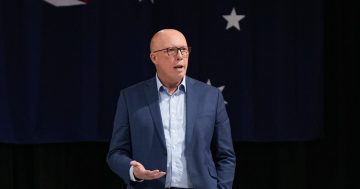
Peter Dutton says nuclear energy is the way to go and a Coalition will build seven plants around the country. Photo: Facebook.
Peter Dutton has revealed the intended locations of seven nuclear power stations he will build across Australia if the Coalition wins the next federal election.
But beyond providing dots on the map, the Opposition Leader has given scant information about his plan.
There are no costings and only a rough timeline committing to having the first plants in operation between 2035 (if using smaller module reactors) and 2037 (if larger reactors are chosen).
The Federal Government would own the assets but form partnerships with experienced nuclear companies to build and operate them.
A community partnership would also be formed in each host community, consisting of experienced local representatives, to help with local engagement and play a role in planning the future of their regions.
Mr Dutton said the community engagement process would occur alongside a comprehensive site study that would include detailed technical and economic assessments.
Each site will be located at a power station that has closed or is scheduled to close.
The locations are Liddell Power Station in NSW; Mount Piper Power Station, NSW; Loy Yang Power Stations in Victoria; Tarong Power Station in Queensland; Callide Power Station, Queensland; Northern Power Station in South Australia; and Muja Power Station in Western Australia.
“Each of these locations offers important technical attributes needed for a zero-emissions nuclear plant, including cooling water capacity and transmission infrastructure,” Mr Dutton said.
“That is, we can use the existing poles and wires, along with a local community that has a skilled workforce.
“A key advantage of modern zero-emissions nuclear plants is they can be plugged into existing grids.
“This means they can effectively replace retired or retiring coal plants and avoid much of the new spending needed for Labor’s renewables-only system, including new transmission poles and wires – all of which will be passed on in the form of higher bills.”
Declaring nuclear energy for Australia as an idea whose time has come, the Opposition Leader said the Coalition believes the nation must have a balanced energy mix to deliver cheaper, cleaner and consistent 24/7 electricity.
He said the option was viable because 90 per cent of baseload electricity, predominantly coal-fired power stations, is coming to the end of life over the next decade, and the current government was relying too heavily on a renewable energy future.
“No country in the world relies solely on solar and wind as Labor is proposing,” the Opposition leader said.
“By contrast, there are 32 countries operating zero-emissions nuclear plants. Another 50 countries are looking to do so.
“Of the world’s 20 largest economies, Australia is the only one not using nuclear energy, or moving towards using it.”
He said every Australian deserves and should expect access to cheaper, cleaner and consistent electricity, but it wasn’t happening because the government’s “renewables-only” solution was failing.
“The government is now talking about a 65 to 75 per cent emissions reduction target by 2035, but won’t release modelling and won’t tell us how much higher power prices will go up,” Mr Dutton said.
“Power bills have already increased by up to $1000 for many Australians, when they were promised a $275 cut, and Labor’s climate target of 43 per cent emissions reduction by 2030 has become unachievable.”
Five of the named sites fall in Coalition electorates, with one in a Labor seat and the other in independent MP Andrew Gee’s seat of Calare, which he won as a Nationals MP but he quit the party over its opposition to the Voice referendum.
Addressing an energy conference in Sydney, Treasurer Jim Chalmers said the Coalition’s nuclear energy plan was “the dumbest policy ever put forward by a major party”.
Clean Energy Council chief executive Kane Thornton described Mr Dutton’s nuclear policy as a recipe for delay and skyrocketing energy bills.
“Australia has no nuclear power industry, so building new reactors would take at least 20 years and cost six times more,” Mr Thornton said.
“This is a policy that would deliver nothing for at least 20 years, result in much higher power prices and risk the lights going out as coal power stations continue to close.
“No Australian community wants a nuclear reactor on its doorstep and no Australian family wants to share communities and roads with truckloads of nuclear waste.
“As ageing and increasingly costly coal-fired power stations exit our energy system, only renewables firmed by storage is capable of preventing blackouts and power price spikes no family or business can afford.”




















